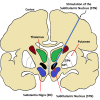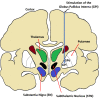Deep Brain Stimulation and Microelectrode Recording for the Treatment of Parkinson's Disease
- PMID: 36110462
- PMCID: PMC9464012
- DOI: 10.7759/cureus.27887
Deep Brain Stimulation and Microelectrode Recording for the Treatment of Parkinson's Disease
Abstract
Parkinson's disease (PD) is a neurological disorder in which nigrostriatal pathways involving the basal ganglia experience a decrease in neural activity regarding dopaminergic neurons. PD symptoms, such as muscle stiffness and involuntary tremors, have an adverse impact on the daily lives of those affected. Current medical treatments seek to decrease the severity of these symptoms. Deep brain stimulation (DBS) has become the preferred safe, and reliable treatment approach. DBS involves implanting microelectrodes into subcortical areas that produce electrical impulses directly to high populations of dopaminergic neurons. The most common targets are the subthalamic nucleus (STN), and the basal ganglia's globus pallidus pars interna (GPi). Research studies suggest that DBS of the STN may cause a significant reduction in the daily dose of L-DOPA compared to DBS of the GPi. DBS of the STN has suggested that there may be sweet spots within the STN that provide hyper-direct cortical connectivity pathways to the primary motor cortex (M1), supplementary motor area (SMA), and prefrontal cortex (PFC). In addition, the pedunculopontine nucleus (PPN) may be a new target for DBS that helps treat locomotion problems associated with gait and posture. Both microelectrode recording (MER) and magnetic resonance imaging (MRI) are used to ensure electrode placement accuracy. Using MER, stimulation of the STN at high frequencies (140<) decreased oscillatory neuronal firing by 67%. This paper investigates methods of intraoperative neuromonitoring during DBS as a form of PD treatment.
Keywords: deep brain stimulation; dopaminergic neurons; globus pallidus interna; microelectrode placement; microelectrode recording; neural impulse generator; parkinson’s disease; pedunculopontine nucleus; striatum; subthalamic nucleus.
Copyright © 2022, Fejeran et al.
Conflict of interest statement
The authors have declared that no competing interests exist.
Figures



References
-
- Parkinson's disease. Dauer W, Przedborski S. Neuron. 2003;39:889–909. - PubMed
-
- Parkinson's Foundation. [ Apr; 2022 ];https://www.parkinson.org/understanding-parkinsons/what-is-parkinsons 2022
-
- Dopamine and Parkinson's disease. [ Apr; 2022 ];Triarhou LC. https://www.ncbi.nlm.nih.gov/books/NBK6271/#_ncbi_dlg_citbx_NBK6271 Madame Curie Bioscience Database. 2000
-
- Deep brain stimulation for Parkinson's disease. Benabid AL. Curr Opin Neurobiol. 2003;13:696–706. - PubMed
Publication types
LinkOut - more resources
Full Text Sources
Miscellaneous
